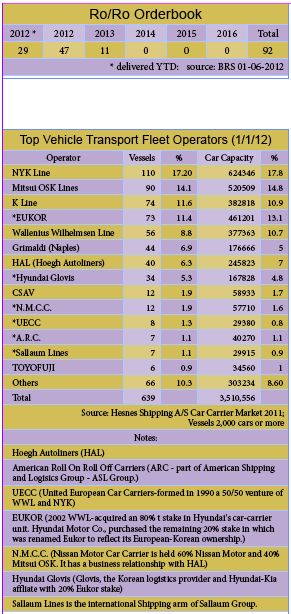
Ro-Ro 2012: The ro ro sector looks poised for recovery
A ‘wait and see’ attitude permeates the Ro-Ro sector. A short Ro Ro orderbook has analysts believing that any upward swing in demand would result in a jump in vessel utilization. But when?
By George Lauriat, AJOT
I sometimes wonder what a Frank Bustard would think of today’s Ro-Ro industry. The larger Ro-Ro vessels now can carry 8,000 cars on three-hoistable decks (6 overall), 138,000 cu/m of space and a ramp weight capacity of 500 tons (see WWL’s MV5 class - MV Tonsberg.) And currently the total Ro-Ro fleet numbers around a thousand ships with about seven hundred of these vessels PCC/PCTC (Pure Car Carrier/Pure Truck Car Carrier). In short, without the PCC/PCTC ships the modern auto industry would be vastly different, and likely less global.
But you ask, who’s Frank Bustard? It might be said that Bustard is the father of the Ro Ro industry. After World War II, Bustard founder of Atlantic Steam Navigation (ASN) chartered three British LSTs (Landing Ship Tanks) and started the world’s first Ro Ro service between Tilbury and Rotterdam. At 3,500 tons, the LSTs would now make a nice oversized/out-of-gauge bit of freight (by way of comparison the new Ro Ro ships are over 41,000 dwt,) but these small ships were arguably the forerunners of the current fleet.
The Ro Ro sector of the shipping industry is at once one of the newest and by virtue of the inherent flexibility of the vessels, one of the most complex. Unlike most other industry sectors, the Ro-Ro industry is constantly waging a war between shipping cubic feet of air against paying cargo. A further complication is like in the case of PCC/PCTC the head haul is often much stronger than the return – if you ship vehicles in one direction, what pays the freight on the return leg? Thus vessel utilization is a key performance indicator for the Ro Ro market sector.
PCC/PCTC sector
There are around seven hundred vessels in the PCC/PCTC segment of the Ro Ro fleet. It is estimated that around 28% of the current fleet is more than 25-years old. In recent years, scrapping has accelerated and most analysts feel that with a flurry of new environmental regulations and higher bunker prices demanding more efficient vessels the scrapping trend will continue. According to BRS stats the orderbook for Ro Ros is pretty small with only 92-ships through 2016 (see chart). Right now the entire 92-ship orderbook ends in 2013.
In this regard, there is something of a wait and see attitude among Ro Ro operators. Hong Kong-based Pacific Basin, a Ro Ro operator offered a commentary shared by many owners in their 1st Quarter Trading Update: “More positive longer term outlook after orderbook delivers (2012-2013) and new Ro Ro trades are developed.” [writer’s italics].
Unfortunately for Pacific Basin, the waiting may be close to over, as last week the Ro Ro operator wrote down the value of its Ro Ro fleet by $190 million (3rd time in four years) and announced plans on exiting the Ro Ro business and concentrating on its dry bulk operations. Pacific Basin has six RoRo ships with the newest two in layup. How much Pacific Basin regroups on the sale of its Ro Ro division is difficult to say. But with a short orderbook and shipyards busy with few slots available, even in a down market the vessels could be very attractive to Ro Ro operators wanting to expand quickly in time to catch the next wave.
It has frequently been remarked, often privately by the containership operators themselves, that their sector is dogged more by too many operators, as much as by too many ships. Agreement between the many players is hard to achieve and even harder to maintain.
That’s certainly not the case with the PCC/PCTC sector of the market. The top fourteen operators account for nearly 90% of the total vehicle capacity and 68% of that total is concentrated in the top five carriers. The business is very incestuous as many Ro Ro owners have joint businesses with competitors (see Top Vehicle Transport chart).







